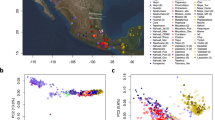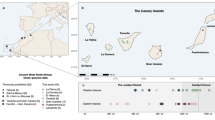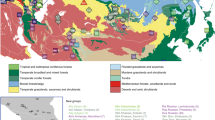Abstract
In a study of human diversity at a highly variable locus, we have mapped the internal structures of tandem–repetitive alleles from different populations at the minisatellite MS205 (D76S309).The results give an unusually detailed view of the different allelic structures represented on modern human chromosomes, and of the ancestral relationships between them. There was a clear difference in allelic diversity between African and non–African populations. A restricted set of allele families was found in non–African populations, and formed a subset of the much greater diversity seen on African chromosomes. The data strongly support a recent African origin for modern human diversity at this locus.
This is a preview of subscription content, access via your institution
Access options
Subscribe to this journal
Receive 12 print issues and online access
$209.00 per year
only $17.42 per issue
Buy this article
- Purchase on Springer Link
- Instant access to full article PDF
Prices may be subject to local taxes which are calculated during checkout
Similar content being viewed by others
References
Cann, R.L., Stoneking, M. & Wilson, A.C. Mitochondrial DNA and human evolution. Nature 325, 31–36 (1987).
Templeton, A.R. Human origins and the analysis of mitochondrial DNA sequences. Science 255, 737 (1992).
Cavalli-Sforza, L.L., Menozzi, P. & Piazza, A. The History and Geography of Human Genes. (Princeton University Press, Princeton, 1994).
Wainscoat, J.S. et al. Evolutionary relationship of human populations from an analysis of nuclear DNA polymorphisms. Nature 319, 491–493 (1986).
Kidd, K.K. & Kidd, J.R. A nuclear perspective of human evolution. in Cambridge Symposium on Molecular Biology and Human Diversity. (ed.Boyce, A.J.) (Cambridge University Press, in the press).
Bowcock, A.M. et al. High resolution of human evolutionary trees with polymorphic microsatellites. Nature 368, 455–457 (1994).
Edwards, A., Hammond, H.A., Jin, L., Caskey, C.T. & Chakraborty, R. Genetic variation at five trimeric and tetrameric tandem repeat loci in four human population groups. Genomics 12, 241–253 (1992).
Batzer, M.A. et al. African origin of human-specific polymorphic Alu insertions. Proc. Natl. Acad. Sci. USA 91, 12288–12292 (1994).
Castiglione, C.M. et al. Evolution of haplotypes at the DRD2 locus. Am. J. Hum. Genet. 57, 1445–1456 (1995).
Tishkoff, S.A. et al. Global patterns of linkage disequilibrium at the CD4 locus and modern human origins. Science 271, 1380–1387 (1996).
Templeton, A.R., Routman, E. & Phillips, C.A. Separating population structure from population history: a cladistic analysis of the geographical distribution of mitochondrial DNA haplotypes in the tiger salamander, Ambystoma tigrinum. Genetics 140, 767–782 (1995).
Jeffreys, A.J., Wilson, V. & Thein, S.L. Hypervariable 'minisatellite' regions in human DMA. Nature 314, 67–73 (1985).
Nakamura, Y. et al. Variable number of tandem repeat (VNTR) markers for human gene mapping. Science 235, 1616–1622 (1987).
Armour, J.A.L. & Jeffreys, A.J. Biology and applications of human minisatellite loci. Curr. Opin. Genet. Dev. 2, 850–856 (1992).
Jeffreys, A.J., Royle, N.J., Wilson, V. & Wong, Z. Spontaneous mutation rates to new length alleles at tandem-repetitive hypervariable loci in human DNA. Nature 332, 278–281 (1988).
Vergnaud, G. et al. The use of synthetic tandem repeats to isolate new VNTR loci: cloning of a human hypermutable sequence. Genomics 11, 135–144 (1991).
Jeffreys, A.J. et al. Complex gene conversion events in germline mutation at human minisatellites. Nature Genet. 6, 136–145 (1994).
Jeffreys, A.J., Neumann, R. & Wilson, V. Repeat unit sequence variation in minisatellites: a novel source of DNA polymorphism for studying variation and mutation by single molecule analysis. Cell 60, 473–485 (1990).
Jeffreys, A.J., MacLeod, A., Tamaki, K., Neil, D.L. & Monckton, D.G. Minisatellite repeat coding as a digital approach to DNA typing. Nature 354, 204–209 (1991).
Neil, D.L. & Jeffreys, A.J. Digital DNA typing at a second hypervariable locus by minisatellite variant repeat mapping. Hum. Mol. Genet. 2, 1129–1135 (1993).
Armour, J.A.L., Harris, R.C. & Jeffreys, A.J. Allelic diversity at minisatellite MS205 (D16S309): evidence for polarized variability. Hum. Mol. Genet. 2, 1137–1145 (1993).
Buard, J. & Vergnaud, G. Complex recombination events at the hypermutable minisatellite CEB1 (D2S90). EMBO J. 13, 3203–3210 (1994).
Armour, J.A.L., Crosier, M. & Jeffreys, A.J. Distribution of tandem repeat polymorphism within minisatellite MS621 (D5S110). Ann. Hum. Genet. 60, 11–20 (1996).
Royle, N.J., Armour, J.A.L., Webb, M., Thomas, A. & Jeffreys, A.J. A hypervariable locus D16S309 located at the distal end of 16p. Nucl. Acids Res. 20, 1164 (1992).
Templeton, A.R.R. ‘Eve’: hypothesis compatibility versus hypothesis testing. Am. Anthropol. 96, 141–147 (1994).
Zischler, H., Geisert, H., von Haeseler, A. & PSabo, S. A nuclear ‘fossil’ of the mitochondrial D-loop and the origin of modem humans. Nature 378, 489–492 (1995).
Monckton, D.G. et al. Minisatellite mutation rate variation associated with a flanking DNA sequence polymorphism. Nature Genet. 8, 162–170 (1994).
Sajantila, A. et al. Genes and languages in Europe: an analysis of mitochondrial lineages. Genome Res. 5, 42–52 (1995).
Flint, J., Boyce, A.J., Martinson, J.J. & Clegg, J.B. Population bottlenecks in Polynesia revealed by minisatellites. Hum. Genet. 83, 257–263 (1989).
Author information
Authors and Affiliations
Rights and permissions
About this article
Cite this article
Armour, J., Anttinen, T., May, C. et al. Minisatellite diversity supports a recent African origin for modern humans. Nat Genet 13, 154–160 (1996). https://doi.org/10.1038/ng0696-154
Received:
Accepted:
Issue Date:
DOI: https://doi.org/10.1038/ng0696-154
This article is cited by
-
Intricacies in arrangement of SNP haplotypes suggest “Great Admixture” that created modern humans
BMC Genomics (2017)
-
A Tale of Two Migrations: Reconciling Recent Biological and Archaeological Evidence for the Pleistocene Peopling of the Americas
Journal of Archaeological Research (2011)
-
WAMI: a web server for the analysis of minisatellite maps
BMC Evolutionary Biology (2010)
-
Poverty, undernutrition, and child mortality: Some inter-regional puzzles and their implicationsfor research and policy
The Journal of Economic Inequality (2008)
-
The population genetics of structural variation
Nature Genetics (2007)



